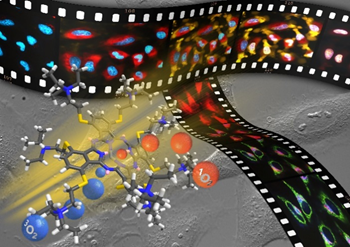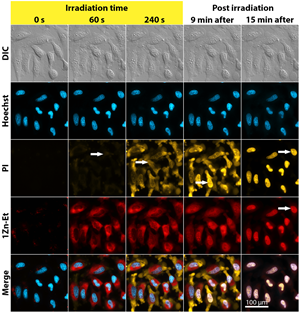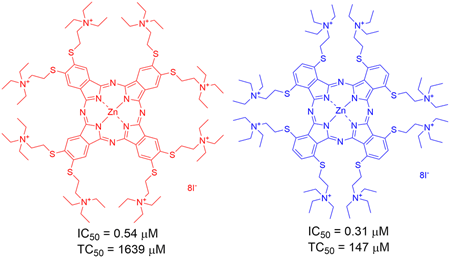 Photodynamic therapy (PDT) is an alternative way of cancer treatment that combines three (potentially) non-toxic components – light, a photosensitizer and oxygen. A drug (called photosensitizer) absorbs energy of light after irradiation in wavelengths corresponding to its absorption bands. A red light excitation is advantageous as the light of these wavelengths penetrates deeper into human tissues. The absorbed energy is then released preferentially by energy transfer to ground state oxygen forming highly reactive singlet oxygen. The singlet oxygen damages surrounding biomolecules leading to cell death. Photon emission in the form of fluorescence that can be useful in cancer visualization is usually present as a minor process.
Photodynamic therapy (PDT) is an alternative way of cancer treatment that combines three (potentially) non-toxic components – light, a photosensitizer and oxygen. A drug (called photosensitizer) absorbs energy of light after irradiation in wavelengths corresponding to its absorption bands. A red light excitation is advantageous as the light of these wavelengths penetrates deeper into human tissues. The absorbed energy is then released preferentially by energy transfer to ground state oxygen forming highly reactive singlet oxygen. The singlet oxygen damages surrounding biomolecules leading to cell death. Photon emission in the form of fluorescence that can be useful in cancer visualization is usually present as a minor process.
Our strategy to development of new photosensitizers from the group of phthalocyanines and their aza-analogues involves synthesis of new compounds, determination of their basic photophysical properties (fluorescence and singlet oxygen quantum yields). Subsequently, selected compounds are tested in vitro on cancer cells (typically HeLa but a range of other cell types is available) for their inherent toxicity in the dark (dark toxicity, TC50) and photodynamic activity upon activation by light (phototoxicity, IC50). A large range of visualization (subcellular localization, time-lapse morphological changes) and biochemical assays (intracellular ROS production, apoptosis/necrosis determination, caspase activity assay, autophagy monitoring etc.) can be performed for the most promising derivatives. Summary of the important findings is mentioned below.
List of our important publications on the topic:
-
Makhseed S, Machacek M, Alfadly W, Tuhl A, Vinodh M, Simunek T, Novakova V, Kubat P, Rudolf E, Zimcik P, Water soluble non-aggregating phthalocyanine and in vitro studies for photodynamic therapy, Chemical Communications, 2013; 49(95): 11149-11151.
-
Machacek M, Cidlina A, Novakova V, Svec J, Rudolf E, Miletin M, Kucera R, Simunek T, Zimcik P, Far-Red-Absorbing Cationic Phthalocyanine Photosensitizers: Synthesis and Evaluation of the Photodynamic Anticancer Activity and the Mode of Cell Death Induction, Journal of Medicinal Chemistry, 2015; 58 (4): 1736–1749.
|

|
To see the video how the cells die after photodynamic treatment go to the official J. Med. Chem. or Chem. Comm. webpage.
|
a) High water-soluble non-aggregating phthalocyanine with rigid arrangement of peripheral cationic substituents was investigated in cooperation with prof. Saad Makhseed (Kuwait University). It reached very high “therapeutic index” (TC50 / IC50) over 17 000 due to low dark toxicity (TC50 = 628 µM) and high photodynamic activity (IC50 = 0.0367 µM). Read more ...
b) Detailed photodynamic effect on the subcellular level was investigated for cationic phthalocyanines with substituents in peripheral or non-peripheral positions. The HeLa cells died after photodynamic treatment by necrosis with only marginal contribution of apoptosis. Relocalization of photosensitizers from lysosomes to other organelles upon irradiation was observed. Interestingly, the derivative with substituents in peripheral positions was characterized by extraordinary low dark toxicity (TC50 > 1500 µM) that is among the lowest for any photosensitizers reported in literature so far. Read more ...
 |
 |
c) Novel type of near-IR absorbing photosensitizers, tetrapyridoporphyrazines, was developed in our laboratory. Their absorption maxima are highly dependent on the nature of the attached substituent, in particular, on the type of connecting heteroatom. Photodynamic activity and mode of the cell death of the cationic derivative is comparable with the above mentioned phthalocyanines. Read more ...